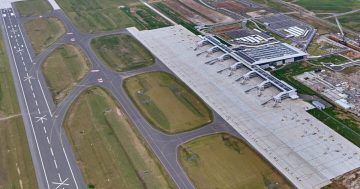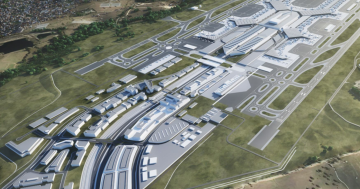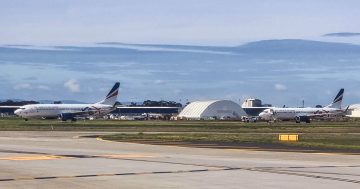
The NSW RFS Boeing 737 ”Marie Bashir” touches down at Western Sydney Airport to mark the start of a major emergency services exercise at the new airport. Photo: Screenshot/SydSquad Live.
The new Western Sydney International Airport (WSI) has welcomed its first large aircraft, with a Boeing 737 touching down on the airport’s runway at Badgery’s Creek in Sydney’s southwest this morning (28 October).
The aircraft – a Boeing 737-700 large air tanker (LAT) operated by the NSW Rural Fire Service (RFS) and named after former NSW governor Marie Bashir – is based at the nearby RAAF Base Richmond during the Australian fire season and is representative of more than 150 similar 737s currently in operation with Qantas and Virgin Australia. Previously, only small aircraft fitted with calibration instruments had landed at the airport.
On hand to welcome the aircraft were Federal Minister for Infrastructure, Transport, Regional Development and Local Government Catherine King, NSW Transport Minister Jihad Dib, the CEO of WSI Simon Hickey, and NSW Police, Airservices Australia, and NSW RFS representatives.
The first landing coincides with a planned multi-agency emergency exercise to be conducted at the airport on Tuesday and Wednesday, 28 and 29 October.
The exercise will involve WSI operational staff and about 300 volunteers and emergency services partners from the NSW Police Force, Fire and Rescue NSW, RFS, and NSW Ambulance as well as federal agencies including Airservices Australia, the Australian Federal Police, Australian Border Force, and around 50 emergency service vehicles.
It is designed to rigorously test the airport’s preparedness, response, and recovery capabilities in accordance with the WSI Aerodrome Emergency Plan (AEP) and to ensure the airport meets CASA certification processes required for the facility’s opening in 2026. It will conclude with a full-scale aerodrome emergency response to a simulated aircraft incident.
Mr Hickey said the exercise was a critical component of the airport’s trial program as the countdown to opening in the second half of 2026 continued.
“This will be the most significant simulation we’ve carried out to date and it’s a positive opportunity for our airport staff and all first responders to test our collective resources, protocols and general preparedness in a safe, controlled environment,” he said.
“It also marks a significant milestone for Sydney’s new 24-hour airport, with our first 737 jet aircraft landing at WSI’s technologically enabled airfield – a big moment that included welcoming many community onlookers and media on site to capture the historic arrival.”

Federal Minister for Infrastructure, Transport, Regional Development and Local Government Catherine King speaks to media at the start of the exercise. Photo: Screenshot/SydSquad Live.
Deputy CEO of Airservices Australia Peter Curran added: “Airservices Australia is making a significant investment in people, infrastructure and technology to ensure we’ll be ready to provide primary emergency response capabilities to Western Sydney International Airport for the safety of aircrew and passengers.
“Our Aviation Rescue Fire Fighting Service will respond to an aircraft incident anywhere on the aerodrome within three minutes of the initial call.
“Airservices’ firefighters at WSI will operate our new fleet of Striker Volterra hybrid fire trucks, which, in full response mode, can launch from a standing start to 80 km/h in under 25 seconds and discharge more than 10,000 litres of water per minute.”
The first landing and exercise come less than a week after the airport conducted a number of other key tests, including instrumented aircraft conducting flight path safety checks on the planned air routes to and from the airport, and a workout of the airport’s baggage-handling system.
The flight checks were designed to allow CASA to confirm that obstacles around the airport are accurately marked on charts to ensure infrastructure such as towers, masts or buildings, or environmental factors like trees, can be safely navigated by aircraft coming in to land at WSI.
WSI chief operating officer Matt Duffy said the baggage exercise allowed the airport to test its new handling systems and procedures, with more than 1800 bags processed.
“We set up a whole lot of dummy flights,” he told media on 23 October.
“And the whole art to this is actually connecting people with their bags. So what we’ve been doing pretty much is suspending the bag system with not having bags in it, so just to really pressure test the system.
“Then we get those 1800 bags and consecutively push them through on multiple flights and make sure they end up in all the destinations where they’re meant to go … great opportunity for us to test the asset as it’s been built.
“This next phase will see our WSI team trial the dozens of technology systems and assets on which our 24-hour airport will rely each day and importantly, test the resilience of those systems as well.
”Ongoing training of staff is also a key part of the program – it allows them to build their skills and experience in a safe, controlled environment so they’re equipped to respond effectively to various simulated scenarios.”





